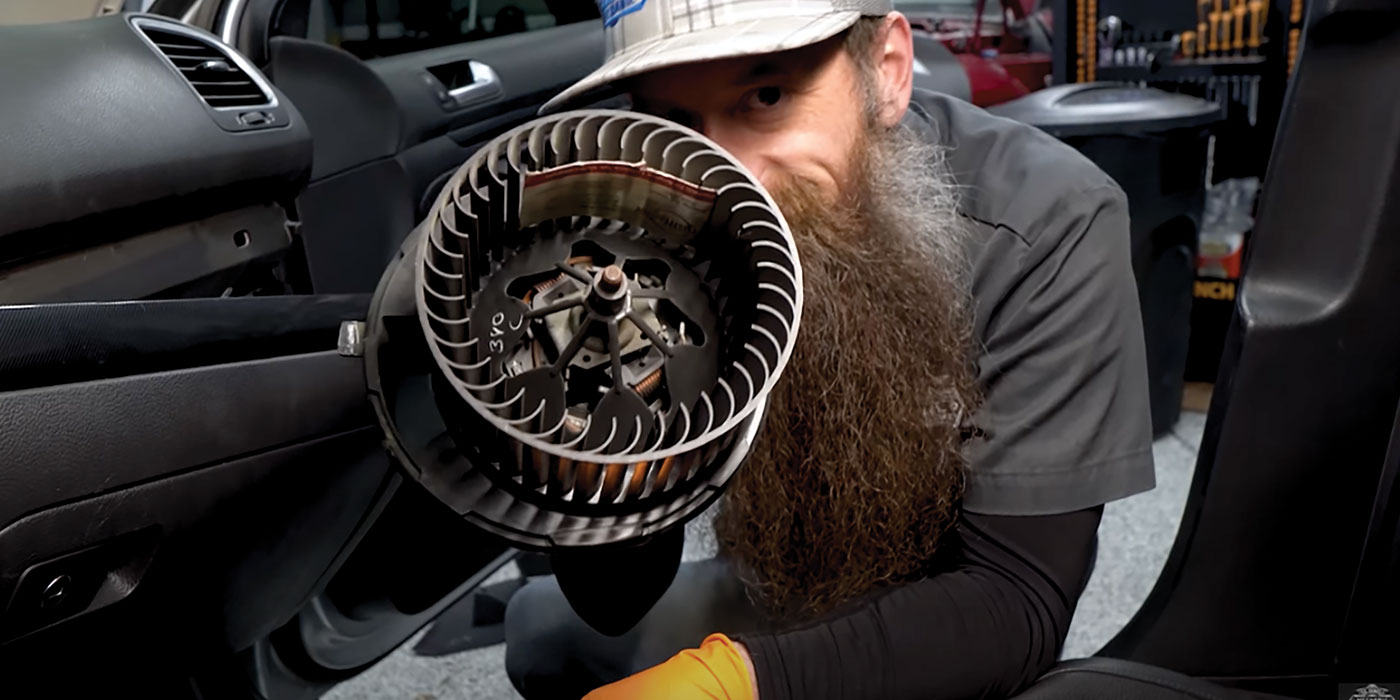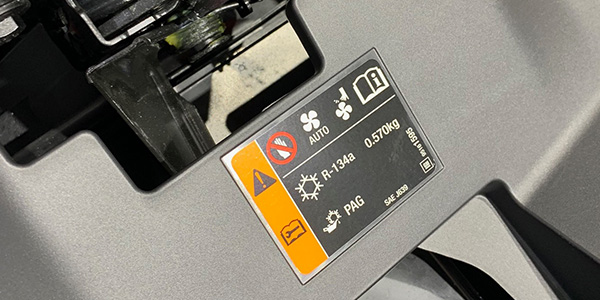SAE to work with the industry and the EPA to create efficient, environmentally sound automotive refrigerant systems, but how will it affect technicians and repair shop profits?
The Society of Automotive Engineers (SAE) recently announced a cooperative research program that will work with the industry and the U.S. Environmental Protection Agency (EPA) to develop and manage a new project to address improved R-134a refrigerant systems for mobile air conditioning systems. The project, named the “Improved R-134a Project” (IRCRP), will build on previous studies and assess technologies that can take R-134a refrigerant to the next level of performance and efficiency, while avoiding costs associated with carbon dioxide (CO2) systems. The project objectives will be to identify technologies to reduce atmospheric leakage by 50% and improve system efficiency by 30%. The project will look at cost vs. benefits of such CO2 systems, while investigating potential passenger compartment load reduction strategies. A major reason for the IRCRP comes from European regulations that are in the finalization stages that will lead to a ban on the use of HFC R-134a in 2011 model year passenger cars sold in Europe. The introduction of the R-744 system will enable car manufacturers to comply with this regulation for air conditioning systems. Even though automotive A/C units account for less than 5% of the total vehicle global warming potential, and the current refrigerant, R-134a, contributes less than 0.4% of total global warming gas emissions in Europe, worldwide concerns on the impact of hydrofluorocarbons (HFCs) from R-134a has forced the automotive industry to search for alternative refrigerants. SAE’s IRCRP, which recently got underway, is expected to continue through 2006. SAE said funding would come from both in-kind industry contributions – such as parts/vehicles/testing time/expertise/people resources – as well as through industry participation fees. These fees will support independent lab testing and other direct expenses. The U.S. EPA also is expected to kick in some money. According to SAE, the project will be organized with two teams, one to address emissions, and one to address efficiency. The emissions team will include experts from tier 1 and 2 automotive suppliers, original equipment manufacturers (OEMs), Mobile Air Conditioning Society (MACS) members, refrigerant suppliers, and hose coupling and fitting suppliers. The efficiency team will include OEMs, tier 1 suppliers and auto interior suppliers. The results of this project will include SAE J-Standards on R-134a system components leakage procedures and methods, SAE J-Standards on Measurement and Testing of HVAC energy/power consumption/efficiency, and consensus ranking of cost vs. benefits of the various technologies. The project will also result in demonstration of new technologies with laboratory results as well as in demonstration vehicles. An initial discussion of the IRCRP project took place in late June during the SAE Alternate Refrigerant Systems Symposium in Scottsdale, AZ. The replacement of current refrigerants with R-744 represents a significant technology breakthrough due to the significantly higher pressure requirements of the air conditioning cycle. Experts believe environmental benefits can be achieved due to the R-744 refrigerant having a Global Warming Power (GWP) more than a thousand times lower than the current HFC R-134a. However, there are service cost issues for the automotive aftermarket industry. Because technicians will not need to recover and recycle the refrigerant at the end of its life, CO2-based systems could impact the bill total a shop writes for providing A/C service and repairs. Eliminating refrigerant recovery and recycling could reduce the parts and labor profit margin a shop sees from this work. And if CO2 supplies for A/C systems are not restricted to only licensed technicians, DIYers may be able to perform a “recharge” to their vehicles themselves. The following are recent developments from various industry suppliers in the quest for developing a CO2 A/C system. Valeo: In late July, Valeo announced that it successfully developed an environmentally friendly automotive air conditioning system which meets future European Union (EU) regulations. The system replaces the current HFC R-134a refrigerant used in car air conditioning systems with the R-744 refrigerant, thereby eliminating the direct impact of air conditioning systems on global warming due to refrigerant leakage. The Valeo R-744 system – based on CO2 – was tested on a demonstration vehicle during the SAE Alternate Refrigerant Symposium in June. Valeo technicians said the demo vehicle successfully concluded three days of formal tests with ambient temperatures up to 43° C in both city traffic and highway driving conditions. Thierry Morin, Valeo chairman and CEO, said he expects to see CO2-cooled A/C systems A/C in the market by 2009. Delphi: Delphi Corporation said it is developing alternative refrigerant air conditioning systems to support the best option for the environment and for their customers. While still improving energy efficiency, these options will significantly reduce the atmospheric effect of direct refrigerant emissions because they are gases with lower global warming potentials. Delphi officials discussed the upcoming changes during a media event in Mortefontaine, France, back in May. Delphi’s analysis showed that air conditioning systems using either CO2 or R-152a comparably reduce the impact on the environment, and that the company considers both coolants as viable options for the future. And, Delphi techs said its CO2 and R-152a test vehicles were among the best-performing entries at the SAE alternative refrigerant workshop held in Phoenix last year. DENSO: Attendees at the 2003 Tokyo Motor Show were given a first-hand look at the operation of a DENSO-designed CO2 A/C system on a Toyota FCHV-4. The Toyota FCHV-4 (fuel-cell hybrid vehicle) is a concept vehicle used to test the DENSO CO2 system. Design engineers at DENSO said they believe CO2 is the future’s most promising alternative for R-134a, and cite CO2’s excellent cooling capacities. Engineers also said CO2 provides efficient cabin heating capacities for electric or hybrid vehicles. Because such vehicles have smaller internal combustion engines (hybrid vehicles) or none at all (electric fuel cell vehicles), there may not be enough heat source created for heating the cabin. A CO2 unit, however, provides heating capabilities for the passenger compartment. How the FCHV-4 CO2 System Works An internal heat exchanger is provided between the outlet of the gas cooler and the evaporator to further cool the CO2 refrigerant, discharged from the gas cooler, by exchanging heat with refrigerant flowing at the low-pressure side of the system. The internal heat exchanger increases the amount of liquid refrigerant at the inlet of the evaporator to increase the cooling performance, resulting in increased Coefficient of Performance (COP) of the system. In an R-134a refrigerant cycle, the accumulator (receiver) is disposed at the high-pressure side. However, in the CO2 refrigerant cycle, the accumulator is disposed at the low-pressure side since the CO2 refrigerant cannot exist under the phase of liquid at the high-pressure side. Because the accumulator is integrated with the internal heat exchanger and the expansion valve, the structure of the CO2 air conditioning system becomes simple and is easy to install in the vehicle. Each component is designed to enable resistance to high operation pressure. Since this unit is designed for a fuel cell vehicle, the compressor for this system is driven by an electric motor, and the compressor and the motor are hermetically integrated together. This results in good sealing performance, a simple structure and easy installation in a vehicle. Visteon: Visteon reports its R-744 (CO2) Climate System is an innovative heating and air conditioning system that significantly reduces the environmental impact of using the vehicle’s air conditioning system. By using R-744 (CO2) as the working fluid instead of R-134a, Visteon provides automotive manufacturers with an environmentally friendly climate solution. This innovative climate system can improve fuel economy and passenger comfort. It is also available with a fully integrated heat pump that provides a fuel-efficient supplemental heat source. Visteon engineers said their R-744 Climate System can improve fuel economy by consuming less power to achieve the same level of passenger comfort as R-134a systems, and that initial tests showed the R-744 Climate System to have greater cooling capacity than R-134a systems of similar size under most conditions. Visteon designers also said R-744 (CO2) is an excellent heat pump fluid, and the system is available with a fully integrated heat pump that can be used as a supplemental heat source, eliminating the need for separate electric or fuel-fired heaters. Notes For more information on the technical aspects of the IRCRP, contact Ward Atkinson (602-956-9313) or, [email protected] For more information on CO2 technology, see “The Future of Cool” from the April issue of this magazine, or use the Search Back Issues function at www.underhoodservice.com using the word “refrigerant.”
A gas cooler, which corresponds to a conventional condenser, cools CO2 refrigerant discharged from the compressor. Because CO2 refrigerant normally exceeds the critical point of CO2 at the high-pressure side, CO2 refrigerant is not condensed by the gas cooler. Instead, through the expansion valve, the CO2 refrigerant is partially condensed as a result of adiabatic expansion. (See schematic above.)
Several States Declare April As ‘Car Care Month’
Several governors across the country have declared April as Car Care Month in their respective states, urging their residents to be car care aware and perform the service necessary to ensure their vehicles are operating in a safe, efficient and clean manner.
Several governors across the country have declared April as Car Care Month in their respective states, urging their residents to be car care aware and perform the service necessary to ensure their vehicles are operating in a safe, efficient and clean manner.
The following governors have issued official state proclamations that April is Car Care Month: Gov. Robert Bentley of Alabama, Gov. John Hickenlooper of Colorado, Gov. Pat Quinn of Illinois, Gov. Rick Snyder of Michigan, Gov. Susana Martinez of New Mexico, Gov. John A. Kitzhaber, M.D. of Oregon, Gov. Nikki R. Haley of South Carolina, Gov. Bill Haslam of Tennessee, Gov. Peter Shumlin of Vermont and Gov. Earl Ray Tomblin of West Virginia.
“We want to thank these governors for officially proclaiming April as Car Care Month,” said Rich White, executive director, Car Care Council. “Car Care Month provides a unique opportunity for the auto care industry and the government to educate car owners on the importance of proper vehicle care. Motor vehicle safety continues to be a major focus for state legislatures and regulatory agencies across the country, so we commend each of the governors for making these important proclamations.”
Spring is the perfect time for motorists to make sure their vehicles are running reliably after a rough winter and before the summer driving season begins. Many independent repair shops and community organizations throughout the country will conduct car care events during April. These events have revealed that three out of four vehicles inspected are in need of some type of maintenance or repair.
The non-profit Car Care Council offers many free tools on its website to help consumers drive smart, save money and be more environmentally friendly, including the popular 60-page Car Care Guide and a custom service schedule and email reminder service.
“By following a service schedule and performing preventative vehicle maintenance, motorists can ensure that their vehicles are safe and dependable. Plus, auto care can help save money in many ways, including reducing fuel consumption and extending vehicle life,” continued White. “We encourage all car owners across the country to get their vehicles inspected this April.”
Intake Manifold Gaskets: A Service Rundown
Back in the days when most
Monroe “Quick Rewards” Program Offers Incentives For Sales Of Monroe Quick-Strut Assemblies
Tenneco’s Monroe brand will offer an incentive to counterpeople for the sale of popular, ready-to-install Monroe Quick-Strut premium replacement assemblies. The Monroe “Quick Rewards” scorecard promotion – available for sales between April 1 and May 31, 2014 – will reward participants with a $10 prepaid card for each pair of qualifying Monroe Quick-Strut units sold.

Three AGM, Gel Cell Battery Myths
Chances are if the battery is not under the hood, it is an absorbent glass mat (AGM) or gel cell battery. These batteries pack a lot of power for their size and weight, which allows manufacturers to shave off a few pounds from the vehicle. That’s a big reason why they are being found more and more on late-model vehicles. Here are three AGM/gel cell myths.
10 Toughest Cabin Air Filter Jobs
There are still many late model vehicles that are not easy to service, and they require a significant amount of disassembly to gain access to the filter. For your shop, this is billable labor. Here are the 10 toughest jobs according to the editors of Underhood Service.
Other Posts
Autel Energy Makes Debut at Detroit Auto Show
Among the products introduced were Level 2 chargers, DC bidirectional vehicle-to-everything charging, DC fast charging and more.
How To Fix a Blower Motor That’s Not Working
The customer is complaining that it sounds like there’s a helicopter behind the dash of his 2014 Jetta.

Selling TPMS At The Front Counter
Kristen Criswell answers common questions that shops experience on a daily basis regarding TPMS.

Servicing R1234yf: Are You Ready?
“What was once a simple creature comfort for upscale motorists, air conditioning systems of today are true thermal management systems, providing not only comfort, but also essential cooling to battery packs and onboard computers in hybrid vehicles.”




